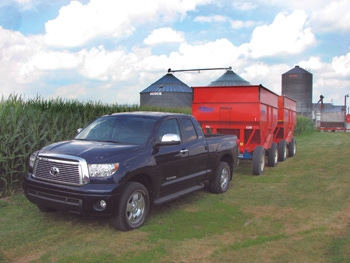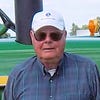
Toyota first manufactured the Tundra in 2000 as a three-quarter-size version of a full-size truck. For the second-generation Tundra, introduced in 2007, the company increased the size of the truck and completely changed the mechanicals.
My first impression of the Tundra 4 x 4 double cab with a 4.6-liter V-8, the truck I tested for a week, was that it looks and drives like a premium-quality SUV. I asked the Toyota people if it has an SUV twin, and they said yes — it is nearly identical to the Sequoia.
New in 2010 is the 4.6-liter engine. It replaces the 4.7-liter motor. The new engine is a descendant of the one that powers the Lexus LS 460 and GS 460 cars. It has a quiet and smooth idle, but growls like a performance car during rapid acceleration. The sound is addictive and it was a real challenge to obey speed laws with the truck.
All Tundra engines have variable valve timing with electronic intelligence. This helps give the engines more low-end torque and gives the engine a wider band of near maximum torque.
Under the hood the engine compartment is clean and organized. It reminds me of the engine compartment of a 1967 Chevelle SS-396.
Toyota says the trucks don’t need a lot of rear axle ratio choices. Ratios available are 3.90, 4.10 and 4.30. Your choice of motor determines the ratio you get. The tester truck cruised at 60 mph turning only 1,500 rpm with its 4.10 ratio. On trucks equipped with V-8 engines, a tow package is available. It includes coolers for engine oil, automatic transmission fluid and power steering fluid. On the 5.7 V-8, the package also includes a transmission fluid heater. Pressing the tow switch makes the transmission change shift points to better handle heavy loads. I pulled two hopper wagons of corn (575 bu.) to market with the truck. I used low-range 4 x 4 to begin pulling the load and then shifted to high-range 4 x 2. There was plenty of power to do the job.
Brakes
All Tundras come with Toyota’s Star Safety System; it includes antilock brakes and brake-force distribution. It reapportions brake force to each wheel to reduce forward tilt. It functions in both normal and emergency braking situations.
Also in emergency situations, “brake assist” applies additional brake pressure. In panic brake situations, drivers often fail to apply enough pressure to the brake pedal. Brake-assist sensors detect panic braking and the system applies additional pressure to help stop the vehicle. Traction control maintains traction on wet, icy and loose or uneven surfaces. It applies brakes individually and reduces engine output to assist the driver with control of the vehicle. The front internal bumper substructure transfers offset front impact forces through the frame rails.
Also standard are side curtain air bags. They inflate whenever the vehicle senses it has reached the point of inevitable rollover. The Tundra also has front seat driver and passenger air bags.
Frame
I read in the brochure that the frame is made in three different sections, each out of a different type of steel. I talked to the people at Toyota to find out more about it. They said, “The frame design allows us to provide the right amount of strength and rigidity at each area of the truck. The front section from behind the bumper to the front of the cab is fully boxed steel. This is done to provide a crumple zone area for frontal impact energy management as well as to manage the torsional forces put out by the engine and transmission.
“The second section runs under the cab area to near the forward rear spring mount. This area is a rolled lip c-channel steel design that has reinforcements at key locations. This section is set up to absorb side impact energy and to provide a comfortable ride for the occupants in the cab. Some frame flexing in the cab area improves overall ride quality.
“The third section runs under the majority of the bed area. It is an open c-channel design that incorporates a bit more frame flexing. This works well with the rear leaf spring suspension to support heavy loads, while providing excellent ride quality in the cab area. This is the sort of frame design one finds on heavy-duty trucks and semi tractors.”
Details
The truck has several little details to make life easier. Large door handles can be opened with heavy gloves on. The tailgate has a lift assist, which also functions as a damper to keep it from slamming open. A lockable tailgate is standard. The bed has several cleats and tie-downs to secure cargo. The truck has a mind-boggling number of storage spaces.
Radio controls are also duplicated on the steering wheel along with telephone controls. Voice-activated GPS, radio and telephone controls are available. Heated outside mirrors with turn signals are an option. A power rear window helps the driver communicate with whomever is helping to hook up to a trailer. The backup camera was extremely helpful; it is an option I would certainly order.
The truck has an impressive dashboard. An information center is integrated into the lower part of the speedometer. It gives an all-time-average fuel economy readout and it has a bar graph of real-time fuel economy. An optional large GPS screen is in the center of the truck’s dashboard. It doubles as a backup screen when the truck is put in reverse. On models without GPS, the optional backup screen is located on one-third of the rearview mirror inside the truck. Sonar sensors front and rear beep when the truck nears an object. The beeping becomes faster and louder the closer you are to the object. At night the dashboard and the myriad of switches and dials surrounding it are lit in a red-orange color; it is a stunning display and reminds me of the cockpit of a jet liner on a night flight.
This truck is a nice dual-duty vehicle. It could serve as a car or a heavy work truck. The V-8 power is awesome. The 0 to 60 time for the 5.7 engine is 6 sec. For the 4.6 engine it is approximately 8 sec.
Toyota’s reputation for durability and quality is formidable. If you have any doubts, check Toyota’s Web site and watch the video “Tundra Deconstructed.” A Tundra was loaned to a 300-square-mile ranch in Texas, and they ran it 100,000 miles in two years time with virtually no problems. The rancher said no other truck has come anywhere close to holding up that well for him. Toyota engineers tore the truck completely apart and looked at each piece for wear or broken welds and found the truck to be in almost perfect condition.
Prices are a bit higher than those of competitors (see sidebar), but my local dealer said they are counteracted by the higher resale value of the truck at trade-in time. Fuel economy is no better than that of the competition.
FIN Fast Facts
Tundra assembly point
San Antonio, TX
Available engines
4.0-liter, 24-valve V-6 — 236 hp
4.6-liter, 32-valve V-8 — 310 hp
5.7-liter, 32-valve V-8 — 381 hp
5.7-liter, 32-valve V-8 — 381 hp, E-85 flex fuel
All have aluminum blocks and heads.
Available transmissions
5-speed automatic aluminum housing for V-6;6-speed automatic aluminum housing for V-8s
Rear axles
9.5-in. ring gear for V-6 and 4.6-liter V-8;10.5-in. ring gear for 5.7 V-8s
Body styles
Regular cab; Double cab; Crew Max cab
Base prices
$23,455 for 4 x 2 regular cab V-6
$27,705 for 4 x 4 regular cab 4.6-liter V-8
The Tundra 4 x 4 double cab, TRD off-road package, 4.6-liter V-8 that I tested is $41,780.
For more information, visit www.toyota.com.
About the Author(s)
You May Also Like






